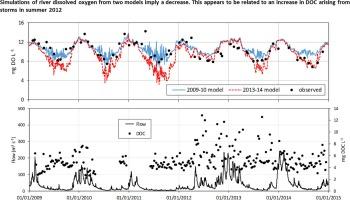Intense summer floods may induce prolonged increases in benthic respiration rates of more than one year leading to low river dissolved oxygen
Abstract
The supply of readily-degradable organic matter to river systems can cause stress to dissolved oxygen (DO) in slow-flowing waterbodies. To explore this threat, a multi-disciplinary study of the River Thames (UK) was undertaken over a six-year period (2009–14). Using a combination of observations at various time resolutions (monthly to hourly), physics-based river network water quality modelling (QUESTOR) and an analytical tool to estimate metabolic regime (Delta method), a decrease in 10th percentile DO concentration (10-DO, indicative of summer low levels) was identified during the study period. The assessment tools suggested this decrease in 10-DO was due to an increase in benthic heterotrophic respiration. Hydrological and dissolved organic carbon (DOC) data showed that the shift in 10-DO could be attributed to summer flooding in 2012 and consequent connection of pathways flushing degradable organic matter into the river. Comparing 2009–10 and 2013–14 periods, 10-DO decreased by 7.0% at the basin outlet (Windsor) whilst median DOC concentrations in a survey of upstream waterbodies increased by 5.5–48.1%. In this context, an anomalous opposing trend in 10-DO at one site on the river was also identified and discussed. Currently, a lack of process understanding of spatio-temporal variability in benthic respiration rates is hampering model predictions of river DO. The results presented here show how climatic-driven variation and urbanisation induce persistent medium-term changes in the vulnerability of water quality to multiple stressors across complex catchment systems.


 求助内容:
求助内容: 应助结果提醒方式:
应助结果提醒方式:


